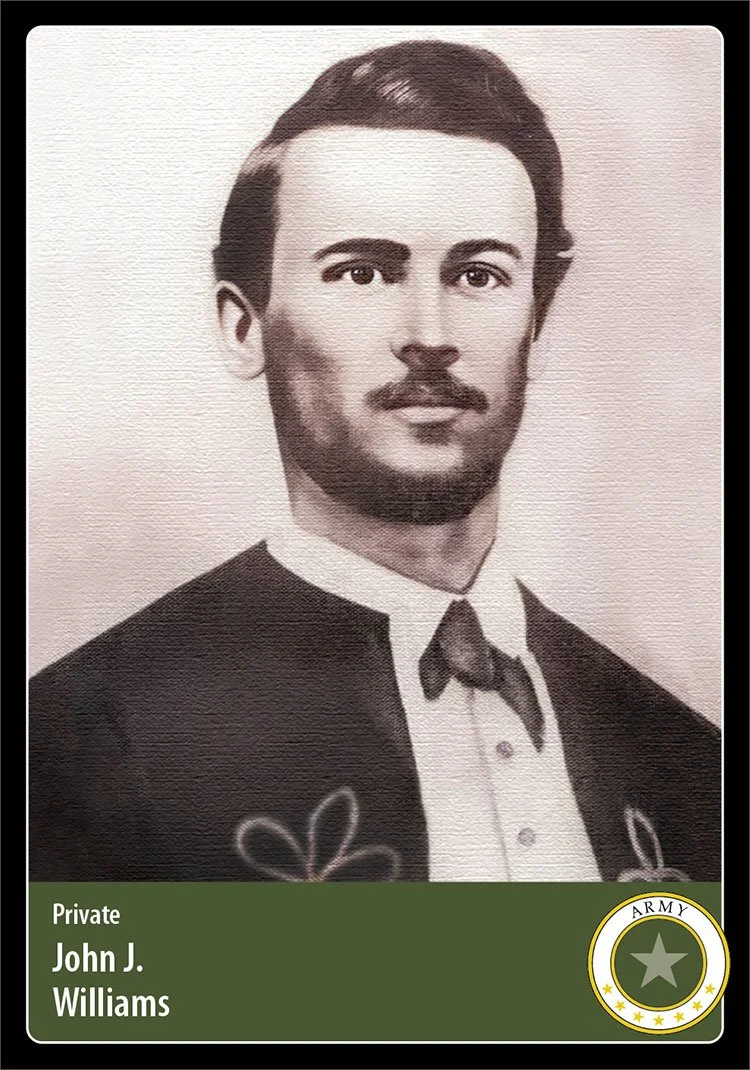Hero Card 94, Card Pack 8
Photo: U.S. Army Center for Military History, Public Domain (digitally restored)
Hometown: Portland, IN
Branch: U.S. Army
Unit: Company B, 34th Indiana Regiment Volunteer Infantry
Date of Sacrifice: May 13, 1865 - KIA near Boca Chica, Texas
Age: 21-22 (exact birth date is unknown)
Conflict: Civil War, 1861-1865
John Jefferson Williams is believed to be the last soldier killed in the Civil War (1861-1865), America’s costliest conflict. A blacksmith and young father of two children, Williams lived in the small Indiana town of Portland, in Jay County.
He enlisted in the Union army’s 34th Indiana Regiment Volunteer Infantry. In January of 1864, the regiment was sent to New Orleans, Louisiana as the war was nearing its end, later embarking to Brazos Santiago, Texas.
While most Civil War battles took place in mid-Atlantic and southern states to the east, control of Texas port cities Corpus Christi and Brownsville was highly valued by both the Union and the Confederacy. Both ports were essential export hubs for the South’s international cotton trade. The Confederacy’s economy—and their ability to wage war—hung in the balance.
The end of the Civil War didn’t take place in one decisive battle. Most consider the official end to be Confederate General Robert E. Lee’s famous surrender of the Army of Northern Virginia to Ulysses S. Grant on April 9, 1865, at Appomattox, Virginia. Confederate President Jefferson Davis was arrested in May 1865, and it wasn’t until August 20 of the following year that U.S. President Andrew Johnson issued a proclamation announcing the end of the American Civil War.
Some fighting took place after Appomattox—partly because news traveled slowly to far-flung encampments, and partly because hundreds of thousands of rebel soldiers refused to surrender.
Because of the importance of the southern Texas ports, both the Union and the Confederacy had troops encamped in the area at the war’s end. Both sides informally agreed to cease hostilities.
Near the port city of Brownsville, in the southernmost tip of Texas, Confederate soldiers received news of Lee’s surrender at Appomattox, President Lincoln’s assassination, and the collapse of the Confederacy. According to the Texas State Historical Association, on May 1, 1865, a passenger aboard a northbound ship on the Rio Grande River tossed a copy of the New Orleans Times to rebel soldiers encamped outside of Palmito Ranch.
With this news, most of the Confederate soldiers in the area left their posts and headed for home. Only those most committed to defending slavery and separation from the Union remained.
When Union Colonel Theodore H. Barrett heard of the mass departure of rebel soldiers, the young commander saw an easy opportunity to make a name for himself by capturing Fort Brown and taking control of the port of Brownsville. Union soldiers were sent to ambush the Confederate encampment at Palmito Ranch in the pre-dawn hours of May 12, 1865.
After an easy victory scattered the rebel soldiers, the Union regiments were surprised later that afternoon when the Confederates returned with a much larger cavalry force. Forced to retreat, Barrett used the 34th Indiana Regiment to set up a battle line, hoping to slow the rebel advance and save his command.
In this last land battle of the Civil War, private John J. Williams of Indiana was lost on May 13, 1865—34 days after Lee’s surrender at Appomattox.
According to the American Battlefield Trust, the human cost of the Civil War is estimated at 620,00 killed, 476,000 wounded, and 400,000 captured or missing. Ironically, the last land battle of the Civil War was a decisive victory for the Confederacy—in a war that was already over.
Sources
The Saturday Evening Post: How the Confederacy Won the Final Battle of the Civil War
National Park Service: 34th Regiment, Indiana Infantry
The State Journal, May 10, 2019: Burgess to commemorate May 13, 1865, death of John Jefferson Williams
World History Project: Battle of Palmito Ranch
Texas State Historical Association: Battle of Palmito Ranch
New Orleans Magazine—Quirky Places: Last Casualty of the Civil War
Historical Marker Database: Battle of Plamito Ranch
American Battlefield Trust: Civil War Casualties
Burial Site: Find a Grave





